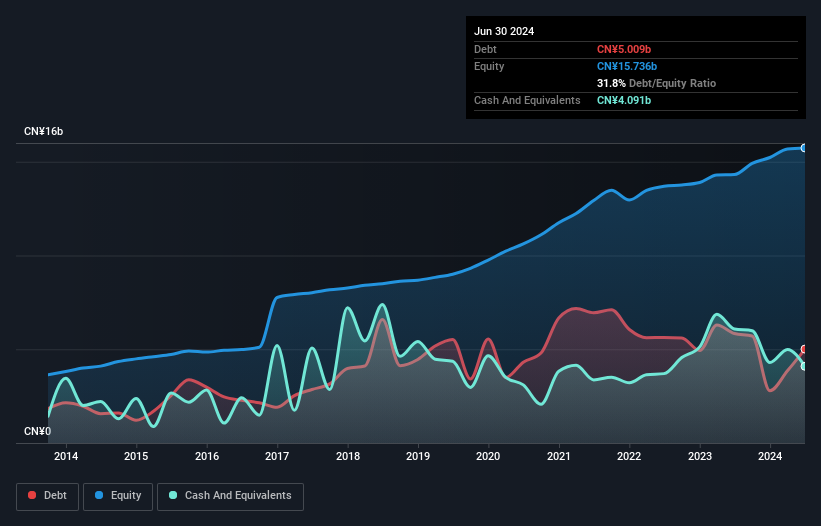David Iben put it well when he said, 'Volatility is not a risk we care about. What we care about is avoiding the permanent loss of capital.' It's only natural to consider a company's balance sheet when you examine how risky it is, since debt is often involved when a business collapses. As with many other companies Shenzhen MTC Co., Ltd. (SZSE:002429) makes use of debt. But is this debt a concern to shareholders?
When Is Debt A Problem?
Generally speaking, debt only becomes a real problem when a company can't easily pay it off, either by raising capital or with its own cash flow. Part and parcel of capitalism is the process of 'creative destruction' where failed businesses are mercilessly liquidated by their bankers. However, a more frequent (but still costly) occurrence is where a company must issue shares at bargain-basement prices, permanently diluting shareholders, just to shore up its balance sheet. By replacing dilution, though, debt can be an extremely good tool for businesses that need capital to invest in growth at high rates of return. The first step when considering a company's debt levels is to consider its cash and debt together.
See our latest analysis for Shenzhen MTC
What Is Shenzhen MTC's Debt?
The image below, which you can click on for greater detail, shows that Shenzhen MTC had debt of CN¥5.01b at the end of June 2024, a reduction from CN¥5.84b over a year. However, it also had CN¥4.09b in cash, and so its net debt is CN¥917.5m.

How Healthy Is Shenzhen MTC's Balance Sheet?
We can see from the most recent balance sheet that Shenzhen MTC had liabilities of CN¥9.48b falling due within a year, and liabilities of CN¥4.73b due beyond that. On the other hand, it had cash of CN¥4.09b and CN¥9.74b worth of receivables due within a year. So its liabilities outweigh the sum of its cash and (near-term) receivables by CN¥378.0m.
Having regard to Shenzhen MTC's size, it seems that its liquid assets are well balanced with its total liabilities. So while it's hard to imagine that the CN¥21.1b company is struggling for cash, we still think it's worth monitoring its balance sheet.
We measure a company's debt load relative to its earnings power by looking at its net debt divided by its earnings before interest, tax, depreciation, and amortization (EBITDA) and by calculating how easily its earnings before interest and tax (EBIT) cover its interest expense (interest cover). The advantage of this approach is that we take into account both the absolute quantum of debt (with net debt to EBITDA) and the actual interest expenses associated with that debt (with its interest cover ratio).
Shenzhen MTC has a low net debt to EBITDA ratio of only 0.33. And its EBIT covers its interest expense a whopping 29.4 times over. So you could argue it is no more threatened by its debt than an elephant is by a mouse. On top of that, Shenzhen MTC grew its EBIT by 52% over the last twelve months, and that growth will make it easier to handle its debt. When analysing debt levels, the balance sheet is the obvious place to start. But ultimately the future profitability of the business will decide if Shenzhen MTC can strengthen its balance sheet over time. So if you're focused on the future you can check out this free report showing analyst profit forecasts.
Finally, while the tax-man may adore accounting profits, lenders only accept cold hard cash. So we always check how much of that EBIT is translated into free cash flow. Looking at the most recent two years, Shenzhen MTC recorded free cash flow of 36% of its EBIT, which is weaker than we'd expect. That's not great, when it comes to paying down debt.
Our View
Shenzhen MTC's interest cover suggests it can handle its debt as easily as Cristiano Ronaldo could score a goal against an under 14's goalkeeper. But, on a more sombre note, we are a little concerned by its conversion of EBIT to free cash flow. Zooming out, Shenzhen MTC seems to use debt quite reasonably; and that gets the nod from us. While debt does bring risk, when used wisely it can also bring a higher return on equity. When analysing debt levels, the balance sheet is the obvious place to start. However, not all investment risk resides within the balance sheet - far from it. For instance, we've identified 1 warning sign for Shenzhen MTC that you should be aware of.
If, after all that, you're more interested in a fast growing company with a rock-solid balance sheet, then check out our list of net cash growth stocks without delay.
New: Manage All Your Stock Portfolios in One Place
We've created the ultimate portfolio companion for stock investors, and it's free.
• Connect an unlimited number of Portfolios and see your total in one currency
• Be alerted to new Warning Signs or Risks via email or mobile
• Track the Fair Value of your stocks
Have feedback on this article? Concerned about the content? Get in touch with us directly. Alternatively, email editorial-team (at) simplywallst.com.
This article by Simply Wall St is general in nature. We provide commentary based on historical data and analyst forecasts only using an unbiased methodology and our articles are not intended to be financial advice. It does not constitute a recommendation to buy or sell any stock, and does not take account of your objectives, or your financial situation. We aim to bring you long-term focused analysis driven by fundamental data. Note that our analysis may not factor in the latest price-sensitive company announcements or qualitative material. Simply Wall St has no position in any stocks mentioned.
About SZSE:002429
Shenzhen MTC
Researches, develops, manufactures, sells, and services home audio-visual and related products in China.
Flawless balance sheet and fair value.
Similar Companies
Market Insights
Community Narratives



